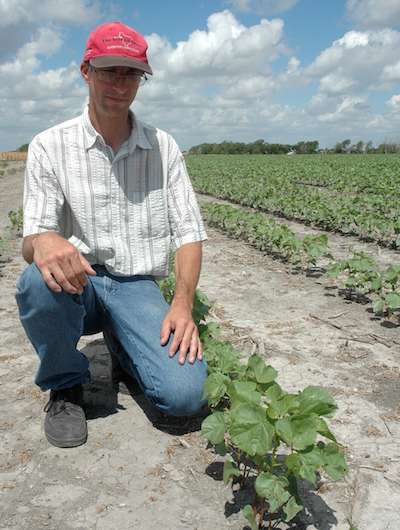Options discussed for farmers battling cotton root rot

Cotton root rot disease continues to be a major threat to Texas cotton, but there are options available to farmers to fend off potential threats or lessen the potential economic hardship, according to a Texas A&M AgriLife Extension Service plant pathologist in College Station.
Dr. Tom Isakeit gave an update on cotton root rot research at the recent Blackland Income Growth Conference in Waco.
The fungicide Topguard Terra has a Section 3 full label registration for control of cotton root rot, Isakeit said. The recent trials in Texas fields focused on evaluating different methods of application. He said these alternative methods are intended to minimize the risk of phytotoxicity that sometimes occur when Topguard Terra is applied at planting.
"With pre-plant treatment application, if the fungicide is right on the planted row 4-6 inches deep, it's quite effective," Isakeit said. "Topguard is very persistent, so it can be applied several weeks before planting. Generally, it's going to remain where it is applied and won't leach out. Our research is demonstrating effectiveness if it is banded on the row before emergence or banded over the emerged seedlings. However, with these methods, rain or overhead irrigation is needed afterwards to activate the fungicide."
Side-dressing has been evaluated over several years and it doesn't seem to work, he said.
"You have to get the fungicide close to the plant for it to be effective," Isakeit said.
At present, application of the fungicide at planting is the only legal method of application. FMC, the manufacturer of Topguard Terra, has applied to the U.S. Environmental Protection Agency for an amended label to include other application methods, and they are hopeful this will be granted prior to the start of planting in 2017, Isakeit said.
"Growers need to follow the current label until the amendment has been approved," he said.
Isakeit said that it was a challenge to establish trials at the Stiles Farm Foundation near Thrall last year. Planting, delayed by frequent rains, was finally accomplished on June 10. Then, it turned dry.
"There was no rain until July 27 and also, very little disease. Additional rain in August led to increasing disease from early September into October, and consequently, provided some useful data," Isakeit said. "In our design, we apply treatments to two adjacent rows, leaving two non-treated on either side. The non-treated rows can verify that the pathogenic fungus is present and active. It's quite common that the fungus is consistently limited to portions of a field.
"Some growers can take advantage of this predictability and, using GPS technology, can apply the fungicide only to portions of the field where it has been previously seen. One of the farmers we worked with this year used prescription maps to apply the fungicide. In one field, out of 101 acres, only 37 percent needed to be treated, resulting in a savings on fungicide costs of $3,200."
In addition to the risk of phytotoxicity with an at-planting fungicide treatment, producers have observed problems caused by clogging of application orifices. This problem can inadvertently show that the fungicide is working, similar to the adjacent, non-treated rows that are used in the experimental trials.
"Growers should pay attention to this problem, particularly first-time users," he said. "Flow meters could identify when clogging occurs. Different application products may alleviate the problem, such as larger orifices in the rebounder or a T-band spray nozzle set higher. If and when the label amendments are approved, growers interested in trying different application methods for the first time should consider leaving a small, non-treated area in the field to identify performance and allow comparisons of crop emergence."
More information: Detailed information about cotton root rot and its management can be found in a factsheet at cotton.tamu.edu/Nematodes/16_FC010_CRR.pdf
Provided by Texas A&M University




















